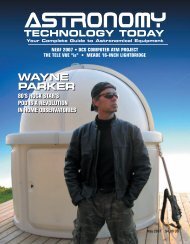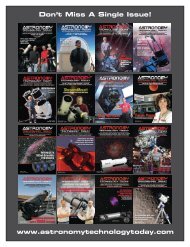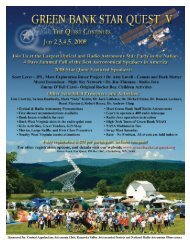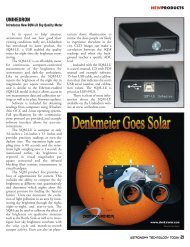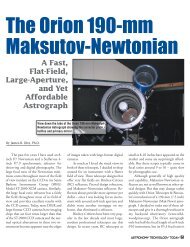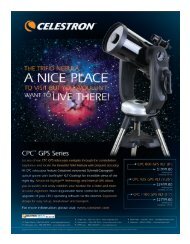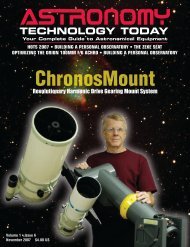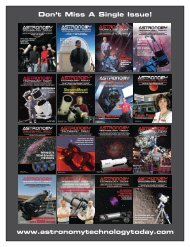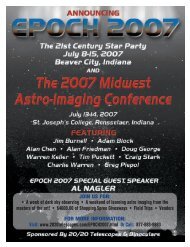iOPTRON - Astronomy Technology Today
iOPTRON - Astronomy Technology Today
iOPTRON - Astronomy Technology Today
Create successful ePaper yourself
Turn your PDF publications into a flip-book with our unique Google optimized e-Paper software.
NEW MEXICO SKIES ASTRONOMY ENCLAVE<br />
home, with their discordant scatterings of detritus<br />
and spoils, astronomical observatories reveal<br />
the reverence with which their owners<br />
approach their favorite activity and, indeed, life.<br />
The view from the <strong>Astronomy</strong> Enclave left the<br />
impression of nature in harmony with man’s<br />
purpose as too few spots have during my travels.<br />
The view within the Enclave did as well.<br />
That said, the <strong>Astronomy</strong> Enclave’s layout<br />
was carefully planned to maximize views of nature<br />
and minimize views of others’ man-made<br />
structures. From the various existing and future<br />
home sites we visited there, we rarely saw the<br />
homes next door. Every lot conveyed a feeling<br />
of privacy and comfortable seclusion.<br />
The Climate<br />
I’ve already mentioned that Cloudcroft’s<br />
summer highs can feel blessedly low compared<br />
to other parts of the country. The month with<br />
the highest average high temperature is June at<br />
73.5°F, with an average low of 44.2°F. The<br />
coldest month is January with an average high<br />
of 41.6°F and low of 18.5°F, but those were<br />
measured at 8600 feet.Temperatures at the <strong>Astronomy</strong><br />
Enclave are higher on average, although<br />
not dramatically so. June there sees an<br />
average high of 82° and low of 48°F, while January’s<br />
average range is from 53° to 21°F.<br />
The <strong>Astronomy</strong> Enclave lies to the east of<br />
the ridge of the Sacramento Mountain Range,<br />
which serves to wring much of the moisture<br />
from air that flows to the area from the northwest,<br />
well before it reaches the <strong>Astronomy</strong> Enclave.<br />
Indeed, the predominant winds of the<br />
area are from the west-northwest. While annual<br />
precipitation is only 30 inches in Cloudcroft,<br />
it is just 20 inches at the <strong>Astronomy</strong> Enclave.<br />
The <strong>Astronomy</strong> Enclave has a unique microclimate<br />
that is superior to that of the surrounding<br />
areas.<br />
The Community<br />
Until last November, I’d known Tom and<br />
Marla Simstad only as folks I met regularly at<br />
astronomy events such as NEAF. I knew nothing<br />
of their backgrounds. As we visited in their<br />
home, Tom explained that they did not move<br />
to the Cloudcroft/Mayhill area to build an astronomical<br />
community, but they were inspired<br />
to build the <strong>Astronomy</strong> Enclave once already<br />
there. Having visited their home and gotten to<br />
know them better, I now understand the significance<br />
of that distinction.<br />
In their previous lives they had, as a team,<br />
worked as builders, developing more than 700<br />
properties in Indiana. Tom was educated in<br />
building construction, surveying and civil engineering<br />
while at Purdue University, but it’s<br />
the couple’s extensive practical experience that<br />
I know to value most, and the lessons of that<br />
shared experience are evident in every aspect of<br />
the <strong>Astronomy</strong> Enclave.<br />
For a development of such dramatic elevation<br />
changes, the private road that serves its<br />
interior is surprisingly wide and meticulously<br />
maintained. While most residents own a fourwheel-drive<br />
vehicle of some description, we<br />
drove our ground clearance-deprived Buick<br />
sedan over every inch of that interior road without<br />
incident, and Marla travels it regularly in a<br />
little car that is slung even lower.<br />
All intra-<strong>Astronomy</strong> Enclave utilities (a<br />
community-wide water system, electric, phone<br />
and Internet) are buried and those few fixtures<br />
that must be maintained above ground for ease<br />
of access are discretely located and, in most<br />
cases, are shielded by native vegetation as well.<br />
The gated subdivision I live in back home<br />
boasts a club house, swimming pool and tennis<br />
courts. The gated <strong>Astronomy</strong> Enclave invested<br />
instead in a 1500-square foot machinist, metalfabrication<br />
and woodworking shop, together<br />
with a 2280-square foot community center<br />
that offers services such as high-resolution<br />
wide-bed printers as well as the more typical<br />
work-out facility, pool table, arts-and-crafts<br />
areas and the like. And because astronomy is<br />
becoming an increasingly online activity, the<br />
<strong>Astronomy</strong> Enclave even exceeds my home<br />
community in the Internet bandwidth available<br />
to its residents.<br />
The formal covenants of the <strong>Astronomy</strong><br />
Enclave are, as you would expect of such a purpose-built<br />
community, both comprehensive<br />
and specific to the unique concerns of astronomers.<br />
The restrictions are certain as to<br />
those factors that are critical to any astronomer<br />
contemplating a life-changing investment, yet<br />
flexible enough as to others to pacify the most<br />
dedicated libertarians among us.<br />
“Who You Gonna Call?”<br />
Among the things you can expect from a<br />
community and region largely populated by expert<br />
astronomers is … well … ready access to<br />
lots of expert astronomers. With them comes<br />
the host of services required to support those<br />
astronomers, not that you’d have to leave the<br />
<strong>Astronomy</strong> Enclave for most of those, given its<br />
fully equipped shop and resident, experienced<br />
machinists and fabricators.<br />
When it comes to major projects, such as<br />
observatory construction, we toured the most<br />
recent roll-off observatory designed and constructed<br />
byTom and his team, and it is, simply<br />
put, the most perfectly functioning and functional<br />
roll-off I’ve seen. I could spend a day in<br />
it just rolling the roof back and forth without<br />
ever getting bored.<br />
Tom and crew have also become particularly<br />
adept at mechanizing and automating the<br />
popular Explora Dome Observatories, although<br />
their expertise extends to many other<br />
brands and designs as well. That’s not to say<br />
that residents of the <strong>Astronomy</strong> Enclave are<br />
limited to the choice ofTom’s professional serv-<br />
<strong>Astronomy</strong> TECHNOLOGY TODAY 69



